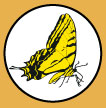Cindy will be happy to guide you to the “hot spots” on grounds for butterflies. She will be wearing her ASDM docent uniform with her name tag. Other docents who love butterflies will be available to you in many of the areas with spring wildflowers.
The trip will cover approximately 1.5 miles on cement paths and flat dirt paths on Museum grounds. After the trip, if you stay for lunch the museum has a cafeteria. If you bring a sack lunch, there are picnic grounds just outside the gate on the west side. You can also buy a drink and have your sack lunch on the cafeteria patio.
Spring wildflowers are beginning to bloom: asters, golden fleece, wolfberry, desert dandelion, parry’s penstemon, fairy duster, Goodding’s verbena, guardiola platyphylla, tropical milkweed, and others. The Botany department plants many species of native plants which are larval foodplants for our butterflies, so chances are good that we will see a variety of species.
So far in March, nineteen species have been seen. These include Pipevine Swallowtails, Sara and Desert Orangetips, Sleepy Oranges, Southern Dogfaces, Gray Hairstreaks, Marine Blues, Echo Azures, Fatal Metalmarks, American Snouts, Queens, Gulf Frittilaries, Texan Crescents, Golden Headed Scallopwings and others.
Photo: Texas Crescent (Phyciodes texana) © Cindy Bethard
Cindy Bethard led an “easy stroll” butterfly walk through the Arizona Sonora Desert Museum grounds on Saturday March 18. Other Friday docents were also happy to help. Fred Heath spotted three Great Purple Hairstreaks in the labyrinth garden, which the group was able to see. And John Z spotted a pipevine caterpillar in the pipevine garden area near the pollination garden. Gay Gilbert showed the group some eggs from a Desert Orangetip, which Fred Heath had spotted earlier. And Martha Mount talked to the group using samples of the many wildflowers blooming on grounds.
The weather was warm and sunny and winds were low. This made for great butterflying weather. The group toured the pollination garden, the desert gardens, the labyrinth area, the Mohave desert area, and the wildflower areas from the cafeteria to the Baldwin theater. We found butterflies in all these places, and we spent some time in the Desert Gardens watching a pair of Cooper’s hawks who were building a nest in a Texas Ebony tree.
The wildflower blooms were in prime season, thanks partly to supplemental watering by Museum personnel. At the end, a few members went to the Mountain Woodland to check out the “dirty socks” plants, willow groundsel, whose blooms have a stinky odor loved by butterflies. There we finally saw a male Sara orangetip.
Not seen by the group but spotted by other Friday docents were a Monarch and a Desert Orangetip. All in all, it was a very successful butterfly trip, especially for such a dry winter. 15 species were seen in all.
Pipevine Swallowtail Battus philenor
'Pima' Desert Orangetip Anthocharis cethura pima
Sara Orangetip Anthocharis sara
Southern Dogface Colias cesonia
Great Purple Hairstreak Atlides halesus
Gray Hairstreak Strymon melinus
Reakirt's Blue Hemiargus isola
‘Echo’Spring Azure Celastrina ladon
American Snout Libytheana carinenta
Gulf Fritillary Agraulis vanillae
Texan Crescent Phyciodes texana
Empress Leilia Asterocampa leilia
Queen Danaus gilippus
Arizona Powdered-Skipper Systasea zampa
Funereal Duskywing Erynnis funeralis
